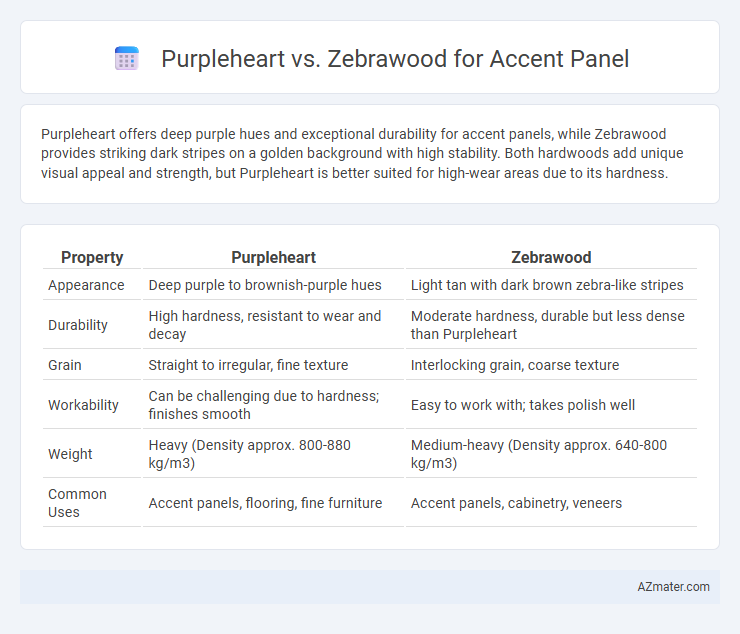Purpleheart offers deep purple hues and exceptional durability for accent panels, while Zebrawood provides striking dark stripes on a golden background with high stability. Both hardwoods add unique visual appeal and strength, but Purpleheart is better suited for high-wear areas due to its hardness.
Table of Comparison
| Property | Purpleheart | Zebrawood |
|---|---|---|
| Appearance | Deep purple to brownish-purple hues | Light tan with dark brown zebra-like stripes |
| Durability | High hardness, resistant to wear and decay | Moderate hardness, durable but less dense than Purpleheart |
| Grain | Straight to irregular, fine texture | Interlocking grain, coarse texture |
| Workability | Can be challenging due to hardness; finishes smooth | Easy to work with; takes polish well |
| Weight | Heavy (Density approx. 800-880 kg/m3) | Medium-heavy (Density approx. 640-800 kg/m3) |
| Common Uses | Accent panels, flooring, fine furniture | Accent panels, cabinetry, veneers |
Introduction to Purpleheart and Zebrawood
Purpleheart, known for its rich purple hue and exceptional durability, offers a striking visual impact for accent panels with color stability and resistance to wear. Zebrawood features a distinctive striped grain pattern reminiscent of a zebra's stripes, combining bold aesthetics with hardness suitable for decorative applications. Both woods enhance interior design by adding texture and color contrast, with Purpleheart providing vibrant warmth and Zebrawood contributing unique visual complexity.
Key Characteristics of Purpleheart
Purpleheart is renowned for its vibrant deep purple hue that darkens to a rich brownish-purple over time, making it a visually striking choice for accent panels. Its high density and hardness contribute to excellent durability and resistance to wear, ideal for enduring decorative applications. The wood's fine, straight grain with occasional waviness adds unique texture and aesthetic appeal, setting it apart from Zebrawood's more contrasting striped pattern.
Key Characteristics of Zebrawood
Zebrawood features striking dark brown to black stripes contrasting against a golden to light brown background, creating a bold and exotic look ideal for accent panels. Its coarse texture and open grain pattern make it highly distinctive, while its natural durability and moderate hardness provide good resistance to wear. Often used in high-end furniture and decorative veneers, Zebrawood's unique aesthetic adds warmth and visual interest to interior design projects.
Color and Grain Comparison
Purpleheart wood exhibits a rich, vibrant purple hue that deepens with age, offering a striking visual impact for accent panels, while Zebrawood features bold, dark brown to black stripes contrasting sharply against a lighter tan or golden background. The grain of Purpleheart is typically straight or slightly wavy with a fine, uniform texture, whereas Zebrawood displays a coarse texture with a more dramatic, interlocked grain pattern that adds dynamic visual interest. Both woods are prized for their unique coloration and distinctive grain, but Purpleheart provides a more uniform color experience, whereas Zebrawood offers high-contrast striping ideal for bold design statements.
Durability and Hardness Differences
Purpleheart exhibits a Janka hardness rating of approximately 2,520 lbf, indicating higher resistance to dents and wear compared to Zebrawood's rating around 1,690 lbf. The dense, oily composition of Purpleheart enhances its durability, making it less prone to splitting and abrasion under stress. Zebrawood, while still durable, is more susceptible to surface scratches and minor impacts, making Purpleheart a preferred choice for accent panels requiring long-lasting structural integrity.
Workability and Finishing Challenges
Purpleheart is known for its dense, hard texture, which can pose moderate challenges in workability but produces a smooth finish when properly sanded and sealed. Zebrawood, characterized by its coarse grain and interlocking fibers, requires careful handling to avoid tear-out and may need extra effort in sanding to achieve a uniform surface. Both woods benefit from pre-finishing treatments, but Purpleheart's natural oils can affect stain absorption, while Zebrawood's striking grain pattern often demands light finishing to preserve its visual appeal.
Cost and Availability Considerations
Purpleheart is typically more expensive than Zebrawood due to its rarity and slower growth rate, impacting overall project budgets for accent panels. Zebrawood is more readily available and cost-effective, making it a popular choice for larger projects or those with tighter financial constraints. Both woods offer unique aesthetics, but budget and supply factors often drive the decision between these two materials.
Environmental Impact and Sustainability
Purpleheart wood, sourced primarily from Central and South America, boasts a rapid growth rate and often comes from managed plantations, contributing to better sustainability compared to the slower-growing Zebrawood, which is native to West Africa and subject to stricter logging regulations due to its scarcity. Zebrawood's harvesting has raised concerns regarding deforestation and habitat loss, making it less environmentally favorable unless certified by reputable organizations like FSC. Both woods can be sustainable choices if sourced responsibly, with Purpleheart showing a slight advantage in reduced environmental impact through faster regeneration and plantation availability.
Best Uses in Accent Panel Applications
Purpleheart offers a vibrant, deep purple hue that enhances accent panels with a bold, luxurious visual impact, ideal for striking furniture and decorative wall features. Zebrawood's prominent dark and light striping provides a unique, textured aesthetic perfect for accent panels in modern interior design and custom cabinetry, adding dynamic contrast and warmth. Both hardwoods are durable and stable, making them suitable for accent panels in high-traffic areas where both beauty and longevity are essential.
Final Verdict: Which Wood to Choose?
Purpleheart offers exceptional durability and a striking deep purple hue that darkens over time, making it ideal for bold, lasting accent panels. Zebrawood features a lighter base with dark stripes, providing a visually dynamic and exotic look but with moderate hardness and wear resistance. For long-term durability and a unique color transformation, Purpleheart is the preferred choice, while Zebrawood suits projects prioritizing distinctive grain patterns and lighter tones.

Infographic: Purpleheart vs Zebrawood for Accent Panel
 azmater.com
azmater.com